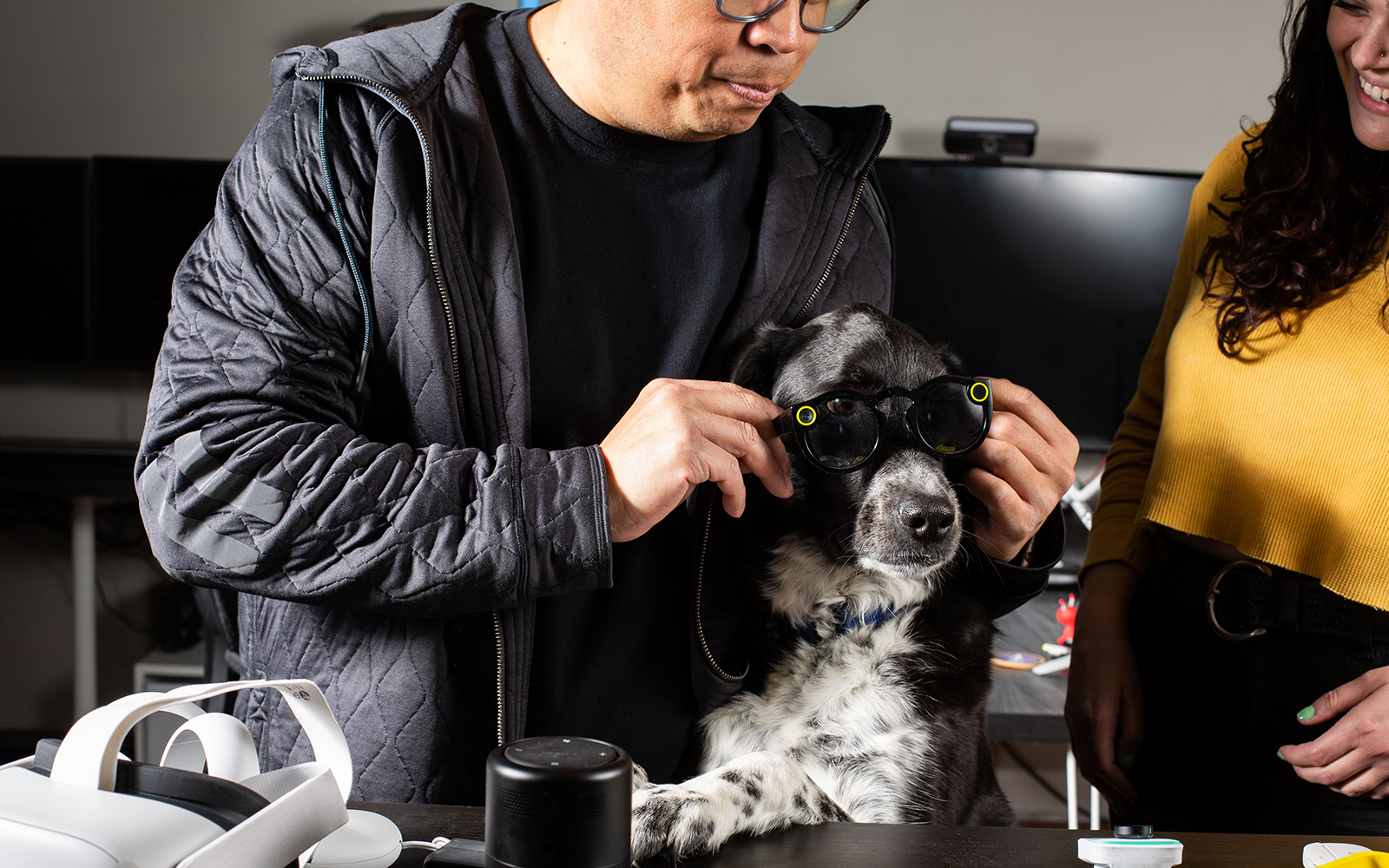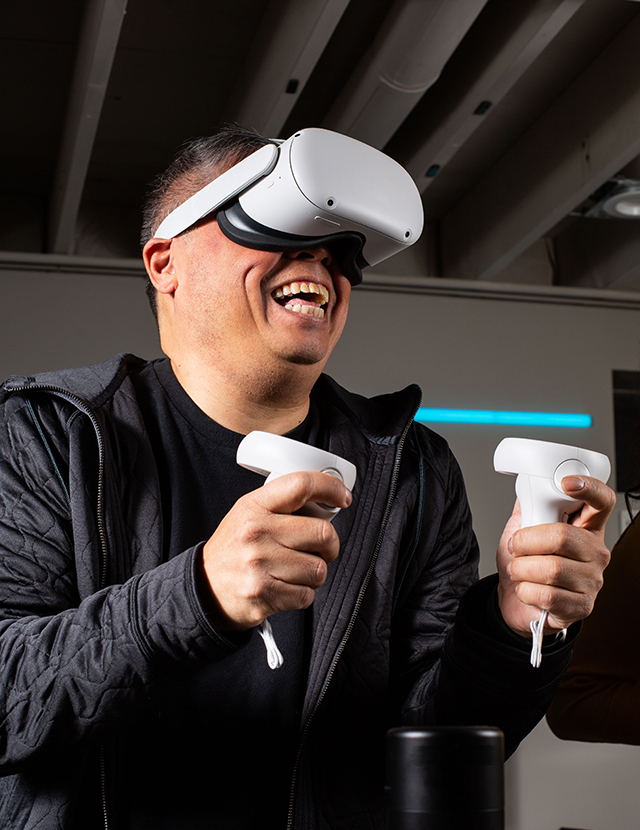|
Getting your Trinity Audio player ready...
|
Step into Manolo Almagro’s subterranean home office, and you’ll be greeted by a mecca of tech. It’s all there. Everything ranging from a wall installation of (usable) charging ports to an early prototype of Google Glass eyeglasses to countless computer monitors displaying crypto prices, a global map of cybercrimes, and an endearing family photo slideshow.
An industry vet, having held C-suite positions in major firms like TPN and Q Division, Almagro provides companies with thought leadership and expertise in digital transformation, experiential marketing, and emerging technology. Today, he is senior manager and AI Solutions architect at EY Consulting in the data & analytics division.
Still, he’s always learning. He points out a ring light positioned above his main desktop computer, aimed at a practical, yet flashy ergonomic office chair. When the corporate world went remote nearly three years ago, Almagro had to get used to joining virtual panels from home and sought his teenage son’s advice on building a Twitch-worthy setup.

The COVID-19 pandemic certainly brought lessons on effective work-from-home strategies. Most of them relaying best practices for companies regarding technology use to ensure team collaboration no matter location, while staying both safe and productive. The digitization of workflows and interactions have reshaped entire organizations, Almagro notes.
In fact, the adoption of digital tech across all aspects of life since the onset of the pandemic accelerated the industry at least five years, as the demand heightened expectations of what automation can do for users.
“Over the past [couple years,] automation and tech have been applied to significantly transform all industries, and the building industry is no exception,” Almagro says. “Digital transformation and automation have been critical for solving key challenges, such as workflow inefficiencies, speeding up processes, shrinking workforces, and bridging the information gaps between on-site and remote workers.”
It’s up to real estate directors and workplace designers to balance the needs of their companies with an openness to new experiences and experimentation. “The majority of today’s remote workers don’t want 100 percent remote work,” Almagro explains. “They would prefer a hybrid model, where they reconnect with their teams in-person at least two to three days a week. Companies have been rethinking on how to use remote work technology to create a more humanized experience when in-office and hybrid employees collaborate.”
Enable Green Setting
Imagine a fully automated future, and you’re bound to create a sterile image in your mind’s eye likely teeming with skyscrapers rather than trees. It may seem difficult to reconcile sustainability with tech—how can the natural environment be preserved in a synthetic future? Yet, the emergence of the greener mindset actually evolved in parallel with automated building.
The 1969 Santa Barbara oil spill sparked public outrage and a demand for environmental legislation, giving way to the first Earth Day in 1970, and in turn helping inspire the Green Building movement. (The US Green Building Council reported in 2021 that more than one billion square feet of space is now LEED certified, an impressive feat for a 40-year period.)

Meanwhile, in the ’70s and ’80s, computers evolved from colossal, room-sized machines to personal devices, soon fundamental to building practices. Before smart buildings (regulated by AI), we had “intelligent buildings,” which used electronic systems (and eventually computers) to manage HVAC systems and lower energy consumption.
Over time, the systems leveraged data and predictive analysis to improve how a building functions—monitoring occupancy health, such as air quality or how resources are used; precooling or preheating water systems; or simply shutting off the lights when it senses an empty building. Tech research firm Gartner predicts there will be more than four billion connected IoT devices in commercial smart buildings by 2028.
“The data collected by smart infrastructure will provide the building industry with new perspectives on sustainability and allow for the evolution of a more human-centric strategy for construction,” Almagro says. “People will be able to interact with their surroundings versus just occupying them.”
As of November 2021, 28 major cities joined the revolution by signing the World Green Building Council’s call to action to hit net-zero by 2030 for all assets within their control. Signed by 112 businesses, the commitment aims to reach total decarbonization of the construction sector by 2050.
“People will be able to interact with their surroundings versus just occupying them.”
Manolo Almagro

Home Is Where the Smart Is
Automation affects not only usership, but the ways in which the spaces are built from the ground up. The 3-D printer, for instance, continuously demonstrates its potential to produce virtually anything a human needs, from prosthetic limbs to entire houses.
Apis Cor CEO Anna Cheninuntai spoke with American Builders Quarterly in 2021 about how her company’s fully automated 3-D printing robot, Frank, executed the buildout of a two-story administrative building in Dubai. The company since introduced 3-D printed homes in Florida, fully customizable with no square footage limits. Leadership also shared plans to take on even more ambitious projects, such as affordable housing communities in California, and even eventually infrastructure on Mars.
The 3-D printing method “drastically improves the construction process in general,” Cheninuntai said in her last interview. “We use less material, and thus generate less construction waste.” Not only does the process reduce logistics cost and the dangers of manual labor, but it’s also an opportunity for sustainability.
By using eco-friendly, geopolymer material in place of cement, there’s less carbon pollution. Other alternatives include engineered mycelium composites (that use natural fungal growth to upcycle agricultural byproducts and waste into synthetic construction material), hempcrete (insulation made of hemp combined with lime binder that resists mold, fire, and pests), and even bricks made of construction waste. If you look at it that way, less is more and more becomes less.

Robot Ready
There’s reluctance to embrace new technologies or an automated future remains ever present both on and off construction sites. (This usually has more to do with anxieties around data security and the loss of human touch in building design, as opposed to a fear of nefarious sentient AI, but you’re likely to find a spectrum of concerns, depending on who you ask.)
But Almagro sees endless potential for tech to evolve our world rather than erase it.
“I used to joke around saying, ‘I, for one, welcome our robot overlords’ when people would ask me about what I thought about the impending automation of everything. But in the past 30 months, I’ve seen how the current labor shortage and the great resignation has had an impact across all industries,” he says.
“If the construction industry handles this transition thoughtfully, we’ll see more productivity; reductions in costs; and best of all, opportunities to retool the existing and future workforce with new skills, like robot maintenance, drone operations, and data monetization and analytics.”


